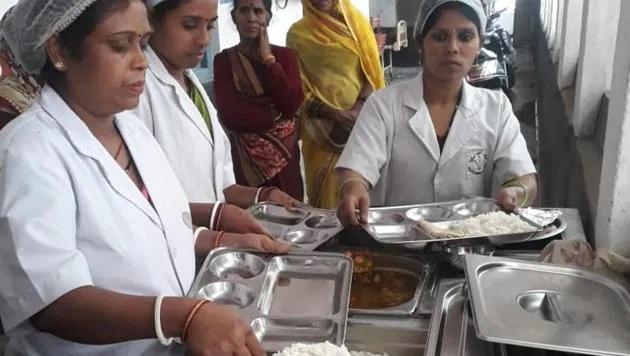Hospital Catering Services
The hospital, today, is one of the most complex and fascinating organizations that mobilizes the skills and efforts of a number of widely divergent groups of professionals, semi-professionals and non-professionals to provide a highly personalized service to individual patients.
Today, the dietary department in hospital ranks as one of the major departments of the hospital, headed by a specialist, the dietitian. “The object of catering in hospitals is to assist the nursing staff to get the patient better as soon as possible. To do this, it is necessary to provide good quality food, to cook it with the minimum loss of nutrients and to provide it to the patients in an appetizing manner.
If the food supplied to the patient is good plentiful, appetizing and nutritionally correct, then it plays a very great part towards the speedy recovery of the patient. – A part possibly as equally important as careful nursing and skilled medical attention. Diet therapy is the use of food; as an agent in effecting recovery from illness. It ‘is concerned with the nutrition of all patients-those receiving normal diets as well as those for whom modified diets have been prescribed.
The normal diet may be modified
– To provide change in consistency as in fluid and soft diets
– To increase or decrease energy levels
– To include greater or lesser amounts of one or more nutrients
egg, high protein, low sodium etc..
– To increase or decrease fiber content of diet
– To provide foods bland in flavor
– To include or exclude specific foods as’ in allergic conditions.
DIFFERENT TYPES OF DIETS IN HOSPITAL CATERING
Hospital menu planning
Regular/Normal diet, soft diet, bland diet, high or low fibre diet high or low protein diet, high or low, fat diet, sodium-restricted diet. Menus in hospitals are generally planned and then formulated into a ‘Diet List”. These are made available to all attending medical staff.
General diets are those which are normally followed in the general wards. Menus are made four days to a week in advance. The dietitian plans menus for each separate meal, specifying the foods to be served in a suitable form. The nursing supervisors will keep the dietary department advised as to the number of patients of each type of diet. Special diets are prepared for those who ate not medically capable or permitted to eat certain food items which are generally used in the making of the menu. These diets are prepared under the supervision of the dietitian or the food service supervisor
Kitchen: The hospital kitchen is planned with much consideration. The kitchen has a receiving area, proper storage facilities, pre-preparation room, preparation area or the main/hot kitchen. The hospital kitchen may also have a cold kitchen.

The kitchen may also be divided into various sections such as pre-preparation area, preparation area, grain cleaning area, tea and coffee section, roti preparation, service and trolley loading area, washing area, stores. The pre-preparation and preparation area may be further divided into separate Indian and Continental areas. The location of storeroom in relation with the kitchen is very important to avoid contamination of the food material and also to prevent pilferage. Separate storage areas for perishable and non-perishable items are desired. The work flow, sufficient spacing between work tables/platforms and the presence of various equipments must be considered when planning the kitchen.
Equipments commonly found in hospital, kitchens:
1.Gas ranges 11.Steamer
2.Refrigerators 12.Chapatti tava and puffer
3.Deep Freezers- 13.Deep fat fryer
4.Walk-in Cooler 14.Pressure Cooker
5.Grinding stone 15.Ovens
6.Masala grinder 16.Salamander
7.Brat Pan 17.Weighing scale
8.Dough mixer 18.Toaster
9.Food processor 19.Bain Marie
10.Rice boiler
SERVICE
Food service for patients may be may be any one of the two general
patterns –
Decentralised or centralised.
In decentralised, service all food is prepared in a central kitchen and sent to the floors, where it is portioned out on trays and served to patients
In centralised service, food is prepared in a central kitchen, trays are set up and food is portioned out in a central serving unit and trays are sent to all patients’ floor.
Menus in Govt. Hospitals Catering:

In Govt. hospitals where only a small percentage of the patients can afford to pay for special service, it is unwise to burden either the individual patient or the hospital with unnecessary expenses. The general menu is:
EMT
Breakfast:
One cup of milk
Two slices of bread
Lunch & Dinner:
Rice
Chapatti
Dal
One vegetable.
Menu in private hospital (First class):
EMT
Breakfast:
Two slices of bread
One bowl of cereal
Egg (any style)
Vegetarian snack
Mid morning:
Fresh fruit juice
Lunch:
Soup
Chapatti
Rice
Vegetable (choice of two vegs)
Pulse
Curd
Fruits
E/Tea – Milk, Biscuits
Dinner:
Same as Lunch
Catering goals
In Hosptial the Catering goals for the hospital catering services are to give the best quality of food to the patients where they also need to:
1. Control catering budget & contract: food, beverages & snacks
2. Choose & order ingredients.
3. Develop Recipes, menu’s taking into consideration dietetic advice, patients age, culture, religion & medical condition.
4. Prepare food to Quality approved standards 5. Deliver food to wards, patients & staff restaurants
6. Serve food to patients at ward level (Nurses/ Hostesses)
7. Provide snacks
8. Maintain & supervise food hygiene at all times.
9. Consider development of patient restaurants or other novel food delivery / outlets.
10. Control cost & monitor waste
11. Audit &develop service delivery
You can also Check : Industrial and Institutional Catering



